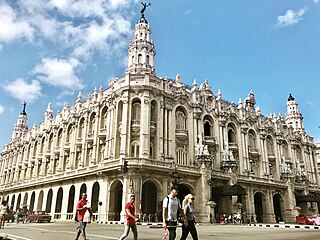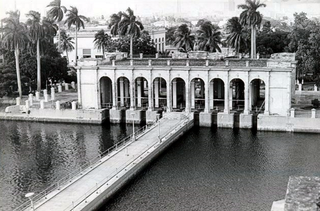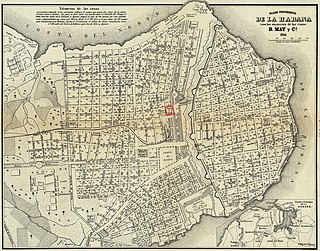
Havana is the capital and largest city of Cuba. The heart of the La Habana Province, Havana is the country's main port and commercial center. The city has a population of 2.3 million inhabitants, and it spans a total of 728.26 km2 (281.18 sq mi) – making it the largest city by area, the most populous city, and the fourth largest metropolitan area in the Caribbean region.

Old Havana is the city-center (downtown) and one of the 15 municipalities forming Havana, Cuba. It has the second highest population density in the city and contains the core of the original city of Havana. The positions of the original Havana city walls are the modern boundaries of Old Havana.

Gran Teatro de La Habana is a theater in Havana, Cuba, home to the Cuban National Ballet. It was designed by the Belgian architect Paul Belau and built by Purdy and Henderson, Engineers in 1914 at the site of the former Teatro Tacón. Its construction was paid for by the Galician immigrants of Havana to serve as a community-social center. Located in the Paseo del Prado, its facilities include theatres, a concert hall, conference rooms, a video screening room, as well as an art gallery, a choral center and several rehearsal halls for dance companies. It hosts the International Ballet Festival of Havana every two years since 1960.

Eusebio Leal Spengler was a Cuban historian. He served as the municipal historian of Havana, as well as the director of the restoration project of Old Havana. Under his oversight, the historic centre of the capital city became a UNESCO World Heritage Site. He also authored books and hosted radio and television programs that recounted the city and its history.
Dr. Carlos Alzugaray Treto is a Cuban diplomat and educator.
The Palacio de los Capitanes Generales is the former official residence of the governors of Havana, Cuba. Located on the eastern side of the Plaza de Armas in Old Havana it is home to the Museum of the City of Havana. It houses exhibitions of art and historical artefacts and many of the rooms are preserved with their original Colonial decoration.
Adriano Buergo, is a Cuban artist specializing in painting, drawing and installations.
Maximiliano de la Luz Borges y del Junco was a well-known Cuban architect and Minister of Public Works during the presidency of Dr. Federico Laredo Brú of Cuba.

Leonardo Morales y Pedroso was one of the most prominent Cuban architect in Cuba in the first half 20th century. In 1900 he entered and attended pre-university studies at De Witt Clinton High of New York, where he obtained a bachelor's degree. In 1909 he graduated of Bachelor in Architecture from Columbia University. After graduating, he returned to Cuba in 1909 where he worked a time in the local architect firm of Newton & Sola with the architect Thomas M. Newton, who was director of the civil construction section of the Secretary of Public Works during the 2nd American intervention in Cuba. In February 1910, he returned to the United States and obtained a master's degree (Doctor) in Architecture from Columbia University in the State of New York. After obtaining his doctorate in architecture he joined in March 1910 the architecture Company Morales y Mata arquitectos, created in 1907 by his elder brother the engineer Luis Morales y Pedroso in association with the master builder Jose F. Mata. In 1917, after having built more than 30 important buildings, they decided to separate from José Mata, who had to stop working because illness and died a short time later. The company changed its name for Morales y Compañia Arquitectos with his brother the engineer Luis Morales y Pedroso as president and Leonardo as Associate together with other 7 architects. He was able to obtain noteworthy real estate commissions partly because of his family's origin, good social connections and social standing in Havana high society. He was named by the Cuban press of the time as the "Havana's architect" and his architectural style is recognized as the "Morales style". During 50 years Leonardo Morales y Pedroso received around 250 notable architectural commissions, some of them include:
Mearson Daniel Zafra Pérez is a Cuban painter, better known as Zafra

The Acueducto de Albear is the name of a water supply system of the city of Havana, Cuba, built in the 19th century by Francisco de Albear.
Lissette Solórzano is a professional photographer born in Santiago de Cuba in 1969. She has worked as a medical photographer, photojournalist, photo curator and graphic designer. She has won many prizes – such as the “Photographic Essay Prize” of the Casa de las Américas - and her work has been exhibited in museums and galleries throughout Cuba as well as in Mexico, in England and in the United States. She is also a member of the Cuban Writers and Artists Union (UNEAC).

Paseo del Prado is a street and promenade in Havana, Cuba, near the location of the old city wall, and the division between Centro Habana and Old Havana. Technically, the Paseo del Prado includes the entire length of Paseo Martí approximately from the Malecon to Calle Máximo Gómez, the Fuente de la India fountain. The promenade has had several names; it was renamed Paseo de Martí in 1898 with the island's independence from Spain. Despite the historic references, the people of Havana simply call it "El Prado".
The following is a timeline of the history of Havana, Cuba.
Reynaldo Agustín Miravalles de la Luz, known as Reinaldo Miravalles, was a Cuban actor residing in Miami.
The following is a timeline of the history of the city of Matanzas, Cuba.

The Teatro Tacón opened in 1838 in Havana, Cuba. Its auditorium contained 2,750 seats. It was built by Pancho Martí, a businessman from Barcelona who moved to Havana, and named after Miguel Tacón y Rosique, Governor of Cuba from 1834 to 1838. In 1847 Bottesini's opera Cristoforo Colombo premiered there. By 1855, so many people attended events that the city issued parking regulations for carriages on performance nights.
The Iglesia del Espíritu Santo at #161 Calle Acosta in Havana, Cuba, was built in 1635 on the corner of the corner of Calles Cuba and Acosta. The Espíritu Santo contains some notable paintings including a seated, post-crucifixion Christ on the right wall, and catacombs. It is considered one of the oldest temples in Havana and it is said that its main interest lies essentially in the simplicity or simplicity of the beautiful stone construction. Free blacks, already numerous, devoted it to the Holy Spirit in 1638.

Arab Cubans refers to Arab immigrants and their descendants in Cuba and the Cuban diaspora. Most of Cuba's Arab community come from Syrian, Lebanese, or Palestinian background.

The Colegio de Belén located between 45th and 66th streets – situated next door to the Tropicana nightclub – in Marianao, Havana, was designed in 1925 by the architect Leonardo Morales y Pedroso and his brother the engineer Luis Morales y Pedroso of the firm Morales y Compañía Arquitectos.









